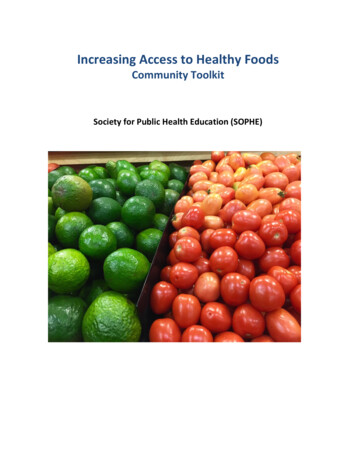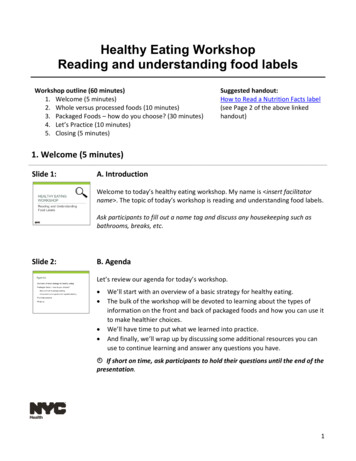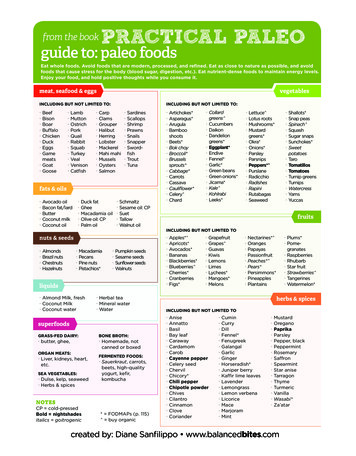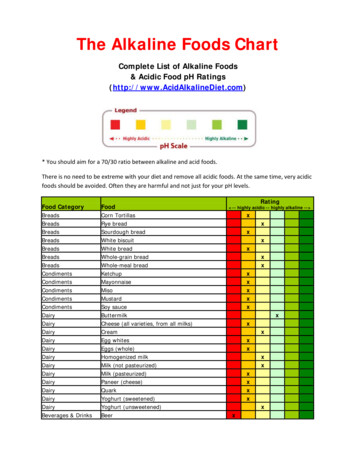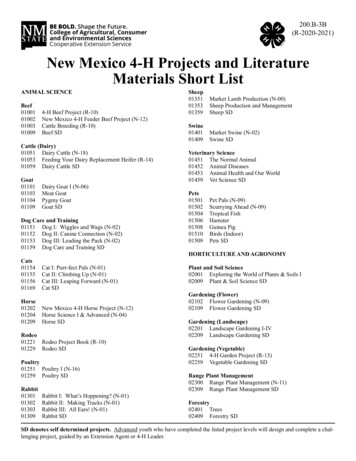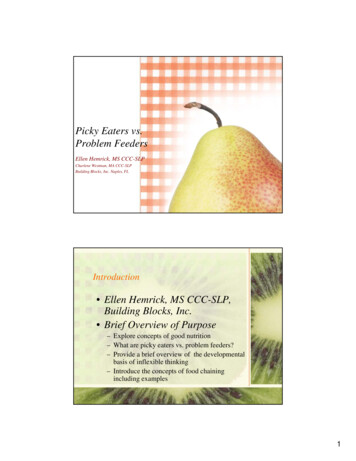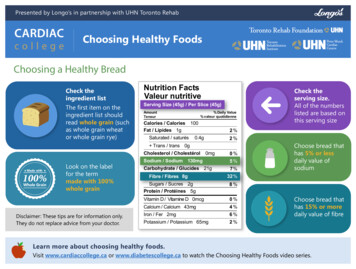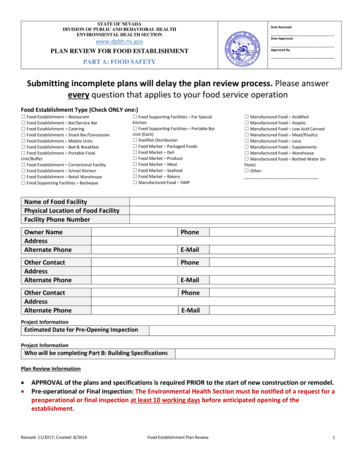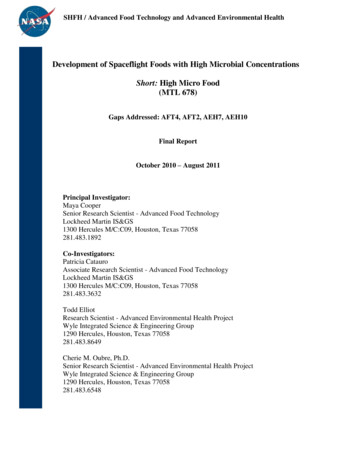
Transcription
SHFH / Advanced Food Technology and Advanced Environmental HealthDevelopment of Spaceflight Foods with High Microbial ConcentrationsShort: High Micro Food(MTL 678)Gaps Addressed: AFT4, AFT2, AEH7, AEH10Final ReportOctober 2010 – August 2011Principal Investigator:Maya CooperSenior Research Scientist - Advanced Food TechnologyLockheed Martin IS&GS1300 Hercules M/C:C09, Houston, Texas 77058281.483.1892Co-Investigators:Patricia CatauroAssociate Research Scientist - Advanced Food TechnologyLockheed Martin IS&GS1300 Hercules M/C:C09, Houston, Texas 77058281.483.3632Todd ElliotResearch Scientist - Advanced Environmental Health ProjectWyle Integrated Science & Engineering Group1290 Hercules, Houston, Texas 77058281.483.8649Cherie M. Oubre, Ph.D.Senior Research Scientist - Advanced Environmental Health ProjectWyle Integrated Science & Engineering Group1290 Hercules, Houston, Texas 77058281.483.6548
EXECUTIVE SUMMARYThe use of bioregenerative food systems has been proposed for long duration spaceflightmissions, though the impact of this type of system on microbial contamination and crewhealth is greatly understudied. Current spaceflight food requirements are inadequate formicrobial monitoring associated with crop production, the use of bulk foods, andsubsequent processing and handling, as well as foods with inherently high microbialconcentrations, such as probiotics, which may be beneficial for crew health. This reviewprovides an initial investigation into (a) the potential of microbial load frombioregenerative produce, (b) the current microbial strains and uses of live cultures in shelfstable foods, (c) a comparison of levels of microbial load in these foods/supplements tocurrent requirements and an assessment of additional risk, and (d) an investigation ofcurrent literature and commercial operations to provide guidance in establishingmicrobiological requirements and testing methods for foods with high and diversifiedmicrobial concentrations.The evidence from this review indicates a need for further research to determine theprocedures necessary for growing and processing regenerative produce and developmentof specific cleaning methods to mitigate microbiological risks. In addition, data miningperformed during this review identified potential benefits for the use of food productswith high microbial concentrations. Specifically, this review has performed an extensivemarket survey to generate a comprehensive list of potential probiotic products, whichshould be evaluated in future research to determine preferred probiotic formulations forspaceflight. Future research would also determine the specific microbial testingprocedures for those formulations and assess the risk of adding the formulation to thefood system.
INTRODUCTIONIn adherence to NASA exploration mission requirements, the space food system mustprovide the necessary nutrients to sustain the health and performance of the crewthroughout the specified mission. For the very short Mercury missions, this requirementwas translated to a food system composed of pureed foods in tubes and bite-sized cubes.As missions extended to days and weeks during subsequent programs, the food systembecame more complex – meal and snack items are produced in single-serving packages,packed into flight containers, and then sent with the crew on the mission vehicle. Withthe exception of Skylab, no refrigerator or freezer dedicated to food storage has flown onany United States space vehicle. Consequently, the food is provided in a shelf-stableformat for storage at ambient temperature. To achieve stability, the food may undergo avariety of microbial mitigation techniques during ground processing. Althoughprocessing the packaged foods to commercial sterility provides a safe food system, thislevel of processing can reduce the quality of the food, including nutritional content andacceptability.The different forms in which space food is provided include the following:1.Thermostabilized – This process, also known as the retort process, heats foodto a temperature that renders it free of pathogens, spoilage microorganismsand enzyme activity. NASA thermostabilized products include pouchedsoups, sides, desserts, puddings, and entrees.2.Irradiated – Irradiation is not typically used to process foods to commercialsterility. However, NASA has received special dispensation from the Foodand Drug Administration (FDA) to prepare nine irradiated meat items tocommercial sterility (FDA 2009).3.Rehydratable – Both commercial and internally processed freeze-dried foodsare included in the NASA food provisions and then rehydrated during themission using the potable water supply. Rehydratable foods are typicallyside dishes, like spicy green beans and cornbread dressing, or cereals.
Ambient and hot water are available to the crew for rehydration of theseitems.4.Natural form – Natural-form foods are commercially available, shelf-stablefoods. The moisture of the foods may range from low moisture (such asalmonds and peanuts) to intermediate moisture (such as brownies and driedfruit), but all have reduced water activity, thus inhibiting microbial growth.These foods help to round out the menu by providing very familiar menuoptions, additional menu variety, and foods requiring no preparation time.5.Extended-shelf-life bread products – Items such as scones, waffles, tortillas,and dinner rolls can be formulated and packaged to give them a shelf life ofup to 18 months. Like the natural-form foods, breads add to menu varietyand address crewmembers‘ desire for familiarity.6.Fresh Food – Foods such as fresh fruits and vegetables, which have a shortshelf life, are provided on a limited basis, more for psychological supportthan as a means to meet dietary requirements.7.Beverages – The beverages currently used on the International Space Station(ISS) and the Space Shuttle are either freeze-dried beverage mixes (such ascoffee or tea) or flavored drinks (such as lemonade or orange drink). Thedrink mixes are weighed and then vacuum sealed inside a beverage pouch.In the case of coffee or tea, sugar or powdered cream can be added to thepouch before sealing. Empty beverage pouches are also provided for drinkingwater.While the above system has proven adequate for Space Shuttle and International SpaceStation missions, the food system has deficiencies for extended missions. NASA has agoal to achieve a manned mission to Mars, a mission lasting approximately 3 years forcrew members. For such a mission to be successful, the food system must providesufficient nutrition while ensuring safety and maintaining palatability. Currently, thespaceflight food system has an average shelf life of 2 years; after that time, nutrient andsensory quality degradation renders the food system inadequate to support missionsuccess. A space habitat food system that involves growing and processing fresh produce
in situ (bioregenerative foods) and launching payloads of unprocessed grain, legumes,and seeds (bulk foods) is being explored as an avenue to higher quality food. However,these foods could contain a high concentration of microorganisms with respect to currentmicrobiological standards for microbial load of spaceflight foods.The extended mission length requires mission planners to also consider avenues toproactively support health beyond preparatory training, exercise during the mission, thestandard diet, and vitamin D supplements. With mounting evidence of a link between theconsumption of probiotic microorganisms and health benefits, including increasedimmune function and improved gastrointestinal function, the inclusion of probiotics inthe spaceflight food system is also being considered. The potential to impact crewmember health through functional foods is yet unexplored but highly relevant to risksassociated with space travel. As with extraterrestrial food processing, probiotic foods andsupplements fall outside of the current microbiological standards for spaceflight.This review seeks to leverage current research to assess the feasibility of developing amicrobially-safe, spaceflight food system that includes extraterrestrial processing and/orprobiotics. If deemed feasible, guidance for standards of microbial acceptability andappropriate testing methods for foods/supplements will be developed during the nextphase. For simplicity of evaluation, the review examines microbial introduction fromfresh food and processing separately from the purposeful addition of probiotics but doesconclude with an overall recommendation on high microbial foods in the spaceflightsystem. Specifically, the review includes: An assessment of the expected microbial load from bioregenerative produce anddeveloped cleaning procedures An assessment of the current strains and uses of live cultures in shelf stable foods A comparison of levels of microbial load in these foods/supplements to currentrequirements and an assessment of additional risk, if necessary An investigation of current literature and commercial operations to provideguidance in establishing microbiological requirements and testing methods forfoods with high and diversified microbial concentration
BIOREGENERATIVE FOOD SYSTEMCrops produced in situ and food processing in space have been often discussed in therealm of crew self-sufficiency and long duration space missions. NASA initiated theControlled Ecological Life-Support System (CELSS) program in 1978 to develop abioregenerative life support model which could provide basic and continuous habitabilityrequirements such as food, drinking water, and breathable atmosphere by using plantsand microbes as the central recycling components. In a bioregenerative food system,vegetables and fruit would be grown on the lunar or Mars surfaces and baseline cropssuch as soybeans, wheat, rice, peanuts, and dried beans would be grown or launched inbulk from Earth. The baseline crops would then be processed into edible ingredients.The edible ingredients and freshly grown fruits and vegetables would be used to preparemeals in the galley.A bioregenerative food system for long duration missions is advantageous to crew andmission planners for a plethora of reasons – better food nutrient quality, fresher tastingfood, lessened risk of menu fatigue, reduced payload, reduced trash production, ability torecycle atmosphere and water through plant growth, and psychological therapy viafarming (Fu and Nelson 1994; Zasypkin and Lee 1999; Monje 2003; Hayashi 2008).However, the bioregenerative system is not without risk. Food insecurity becomes aprominent concern when the diet is dependent upon a specified crop harvest; crops canfail due to inadequate light, air flow, and water conditions, microbial attack, and theinherent challenges of growth in a microgravity or hypogravity environment (Schuerger1998; Leach 2001; Stutte 2006). An adverse psychological impact to the crew occurswhen the plants die prematurely or become infested (Bates 2011). The change from acommercially sterile, prepackaged food supply to a more dynamic stream food supplyintroduces the risk of microbial contamination of the food supply as well. Because of thechances of microbial interaction with crops and of microbial contamination of the foodsupply in storage and cooking, the bioregenerative food system is considered a highmicrobial food system.
Crop ContaminationWhile limited research has been conducted to determine which microbes have thegreatest probability of impacting the food system in space, knowledge from analogs andterrestrial data can be applied to draw conclusions on the potential microbial impact.More than 80% of terrestrial greenhouse epidemics are due to the fungal generaPhytophthora, Pythium and Fusarium, which have been found in life support system testbeds (Fjällman and Hall 2005). Determining the risk to crop production is difficultbecause pathogenic relationships in space do not necessarily correspond to known Earthrelationships. One instance is recorded from Shuttle experimentation where a fungus,Neotyphodium endophyte, destroyed wheat plants even though the fungus normally doesnot host on wheat (Bishop 1997). The microbes noted in the closed International SpaceStation environment – bacteria belonging to Staphylococcus sp. genus and fungi of theAspergillus sp. and Penicillium sp. genera – would likely be the same to survive in aclosed planetary surface habitat and influence plant growth and food preparation surfaces(Novikova 2006).Pathogen presence on the crops within an extraterrestrial growth chamber could havesignificant impact to crop yield, resources required for produce sanitation, and theinstances of foodborne illness among the crew. Although some of the common risks ofcontamination of produce on Earth are eliminated in the controlled environment of space,some risks are magnified. The greatest driver in risk difference is that hydroponicfarming involves a closed environment absent of soil, as pictured in Figure 1. Table 1lists the identified sources of contamination for fruits and vegetables in a spacehydroponic system as adapted from Beuchat and Ryu (1997). For instance, wild anddomestic animal pathogens are a terrestrial risk of plant growth, but eliminated for spacemissions because such animals will not be present at the space habitat. On the otherhand, insects may be transferred inadvertently to space with some of the other bulk fooditems, thereby continuing the threat of insect contamination. The air handling system isof greater import since it is a closed environment. Despite these possibilities, the mostlikely sources of contamination in the bioregenerative food system are contamination ofthe nutrient solution of the hydroponic growth chambers and human handling. The
pathogenic risk of the nutrient solution is especially high if the solution is not adequatelycontrolled due to proposed accumulation of many recycle streams into the nutrientsolution. In the NASA experimental profile for NASA/MIR - Greenhouse 1, thebioregenerative system used a microbial reactor that processed urine, feces, inedible plantmass, and grey water for recycle back to the biomass growth (1995). This system isdiagrammed for review in Figure 2.Photo by: FAO/ J.IzquierdoPhoto by: USDA/Scott BauerFigure 1. Environmental Differences of Hydroponic Farming and Soil FarmingTable 1. Sources of pathogenic microorganisms on fresh fruits and vegetables(Adapted: Beuchat and Ryu 1997)PreharvestIrrigation waterWater used to apply fungicides,insecticidesAir (dust)InsectsHuman handlingPostharvestHuman handling (workers, consumers)Sorting, packing, cutting, and further processingequipmentTransport containersIceInsectsImproper storage (temperature, physical environment)Air (dust)Wash and rinse waterImproper packaging (includes new packagingtechnologies)Cross-contamination (other food in storage, preparation,and display areas)
Figure 2. Bioregenerative life support systems represent a likely method for recyclingwaste and providing food, water, and oxygen on long-duration space flights.(From: NASA 1995)The probability of contaminated hydroponic crops due to the presence of pathogens in thenutrient supply has been well-documented by researchers attempting to clarifymechanisms by which foodborne illness outbreaks may have occurred. Guo (2002)reported that salmonellae could be transported from an inoculated nutrient solution to thehypocotyls-cotyledons, stems, and leaves of young tomato plants in a hydroponic growthsystem. Additionally, hydroponically grown radish sprouts have been thought to serve asa vehicle in the transmission of Escherichia coli O157:H7 infection of over 6000schoolchildren in Japan (Hara-Kudo 1997; World Health Organization 1996). TheHepatitis A virus has been shown capable of contaminating green onions grownhydroponically and in soil; research was spurred by a hepatitis A outbreak in November2003 stemming from green onions (Chancellor 2006). Pathogens have been noted tosurvive internally in lettuce, spinach, and strawberries as well (Yu 2001; Niemira 2008;
Sharma 2009). Once the pathogens reside within the plants, surface treatments are unableto remove the pathogen.Bulk Food ContaminationThe next consideration of microbial impact to the bioregenerative system is bacterialcontamination that could be introduced along with the stowed food from Earth. Thefoods under consideration for bulk commodity shipment to an extraterrestrial habitat arerice, wheat, soybeans, peanuts, and dried beans. Additionally, a host of dried spices andother dry goods, such as sugar, yeast, and spray-dried, pasteurized eggs, are also plannedfor stowage to complement a bioregenerative food system. Due to the low water activityof most of these foods, most microorganisms cannot effectively utilize these substratesfor growth and survival. Molds are the primary microorganism of concern for the drygoods because molds can grow at reduced water activity levels. Molds tend to change theflavor and aroma of foods so sensory detection prior to ingestion is often possible. Ofgreater concern is the potential production of mycotoxins, and specifically aflatoxin, byfungi within the food which is not detected prior to consumption.The baseline crops, if launched from Earth, would be minimally processed prior toshipment, except for any irradiative treatment or specialized packaging to add to the foodstability. Environmentally-controlled storage may also be required to ensure the qualityof some of the stowed ingredients throughout the five years. Table 2 shows the provenstabilization conditions – processing and/or storage - that ensure functional andorganoleptic quality for many of the proposed baseline crops. Most of the stabilizationconditions do not incorporate a microbial kill step. Consequently, control of pathogenlevels becomes paramount to maintaining the food supply. Similar to current NASA foodsafety procedures, bulk foods can be tested for microbial levels prior to final packagingand storage. Larger food quantities will drive a more complex sampling plan but the riskof bacterial contamination from the ground is minimized with these controls.Alternatively, technologies that maintain food functionality and stability while allowingfor elimination of bacteria should be investigated.
Table 2. Methods to Ensure Long-Term Storage of Bulk Food IngredientsBulkCommodityRiceStabilization ConditionsAim of MitigationShelfLife30 yReferenceSealed hermetically in #10cans, flushed with N2.Oxidation, infestationWheatBerries 10-12% moisture and dry,unheated storageWheat enzymeactivities andmicrobiological, mainlymold, spoilage25 yFellers and Bean (1977)Wheat FlourIrradiate w/ 1 kGyInsect infestation2yPixton and others (1976)Lorenz and Miller (1975)WholeWheat FlourIrradiate w/ 1 kGyInsect infestation6 moMarathe and others (2002)Dried Beans/LentilsRefrigerated hypobaricconditions (4.5 C, 50-60%RH, pressure of 125 mmHg)Hard-to-Cook (HTC)phenomena2yBerrios and others (1999)DriedSoybeans 12% moisture, storedbelow 15 C and 50% RHOxidation,5yShurtleff and Aoyagi (1979)Peanuts(in-shell)Dry to 10% moisture, storeat 0 C in moisture barrierpackagingMold development,insect infestation,oxidation24 moShewfelt and Young (1977)Seeds(mostspecies)NoneN/AStorage at low temperatureand humidityDeteriorative chemicalreactions4y50 -100 yCoons and others (2004)Priestly (1986)Roos and Davidson (1992)Food processing and human handlingMost terrestrial foodborne illnesses result from mistakes at the processing facility or inthe preparers‘ kitchen, not with the ingredients themselves. McCabe-Sellers and Beattiereported that the top five contributing factors of recognized foodborne illness in theUnited States from 1993 – 1997, listed high frequency to low frequency, were improperholding of hot or cold food, poor personal hygiene, cross contamination, inadequatecooking, and unsafe food source (2004). The translation of these factors to a spacehabitat is primarily affected by the absence of raw animal products and constraints onwater and power usage.The absence of raw meat and unpasteurized egg and dairy products in postulated spacehabitat food systems decreases the risk that cross contamination or inadequate cookingwill result in foodborne illness of the crew. Likewise, the most likely impact of improper
holding temperature of prepared foods is sensory unacceptability, not microbial growth.The limited raw food supply is advantageous to the crew in this regard.The resource constraints of a space habitat (water, power, living volume) increase the riskthat foodborne illness will result from the ingredient processing, food preparation, orhuman handling interactions. For example, Calcivirus, the viral family that includesNorovirus, is the leading cause of gastroenteritis in the United States is spread by thefecal-oral route of transmission and has demonstrated remarkable virulence on cruiseships due to the contained environment (McCabe-Sellers and Beattie 2004). Calciviruscan be transmitted via contaminated surfaces, hands, people, food, and water supply.Limited resources impact the ability to proactively control microbial populations inclosed environments. Water will likely be the most demanded consumable resource during a habitatmission. Without adequate hot water for hygiene, dish washing, and foodpreparation, the probability of spreading Calcivirus and other viruses increases.In the FMARS2007 study – an Antarctica-based Mars analog at the FlashlineMars Arctic Research Station, crew members showered only once per week andused hand sanitizer in lieu of hand washing to conserve water (Bamsey 2009).The water conservation methods seen during FMARS2007 could prove dangerousto a real crew, as studies have shown alcohol-based sanitizer to be ineffectiveagainst Calcivirus populations (Liu 2010). Power is required to keep hot foods hot, to keep cold foods cold, and to create hotwater. In a bioregenerative system, where multiple menu items are beingprepared in a small galley area, the need to warm foods for an hour or more whilea complementary dish is being prepared is probable. The food warming time isextended even longer if the crew eats at staggered meal times due to missionresponsibilities. Maintaining the correct food temperature will require powerinputs. Hot water and, in some cases, steam, are required for food processingequipment and dish sanitation; hot water is required for hand sanitation. If powerusage becomes a concern during the mission, power used during food preparationmay be limited, thereby increasing risk of foodborne illness.
Testing ProceduresThe current evidence indicates a clear potential for microbial contamination associatedwith crop production, the use of bulk foods, and their processing and handling. However,to fully elucidate these microbial risks, the contamination potential must be put in contextwith established methods to mitigate the risk. Thus, the final consideration of microbialimpact to the bioregenerative system is the process to ensure the safety of the foodsystem of a remote habitat. A variety of methodologies and practices are utilized topromote and verify the microbial safety of terrestrial food systems or food productionfacilities from farm to table. Notermans (1997) identified the conventional and rapidmethods for microbial evaluation of food systems as shown in Table 3 below. A similarsafety program would need to be implemented for an extraterrestrial bioregenerative foodsystem.Table 3. Conventional and Rapid Microbiological Methods in Safe Food ProductionUse of microbiological methodsSafe food productionMonitoring and surveillanceDetection of pathogensDetection of indicator organismsDetection of bacterial toxinsStorage TestsMCT (microbial challenge testing)Predictive modelsPerformance testingMathematical modelsManagement of safe food productionGMP dHAACP eHazard analysisIdentification of critical control pointsMonitoringVerificationFailure analysisFood borne disordersTesting of reported outbreaksSentinel studiesRisk assessment studiesaRelativeImportance aMost Suited MethodsRapid andConventional bAutomated c - - - - Necessity and convenience of a microbiological technique for obtaining reliable and/or applicable results
bMethods based on enumeration of organisms, such as determination of colony-forming particles, and methodsallowing organisms to be obtained in a pure state for a further characterization. Conventional methods for detectingbacterial toxins are those using animal models.cMethods that detect organisms on the basis of production of metabolic products or compounds. Such methods forbacterial toxins use a direct test system for the toxin itself.dGMP (Good Manufacturing Practice)eHAACP (Hazard Analysis Critical Control Point) a systematic approach to food safety that identifies and mitigates thebiological, chemical, and physical process hazards of a given production cycle.PROBIOTICSProbiotics are defined as live organisms that, when ingested in adequate amounts, confera benefit to the host (FAO and WHO 2002). Probiotics have a long history that datesback to ancient times, particularly the consumption of fermented milk and lactic acidbacteria for health. Medical historians cite both a Persian version of the Old Testamentthat describes Abraham consuming sour milk, and Roman historian Plinius‘recommendation of fermented milk for gastroenteritis as early as 76 BC (Schrezenmeirand de Vrese 2001). As interest in alternative medical therapies has grown, interest inprobiotics in general has also grown; Americans‘ spending on probiotic supplements, forexample, nearly tripled from 1994 to 2003 (NCCAM 2008).The class of microorganisms recognized as probiotics in humans is relatively small.Almost exclusively, the bacteria come from two groups, Lactobacillus orBifidobacterium, though Saccharomyces boulardii, a yeast, is also considered a probiotic(NCCAM 2008). The criteria for a classification as a probiotic, according to the Foodand Agricultural Organization (FAO) and World Health Organization (WHO) (2002), isas follows:1. The genus and species of the strain must be identifiable.2. The strain must have proven health efficacy in vivo.3. The strain must be safe for consumption and without contamination in its deliveryform.
Research on the benefits of probiotics has increased dramatically over the decade,especially in the last 5 years. There is a wide-range of benefits that have been identifiedand are currently being validated in double-blind placebo trials. As research progresses,it seems that the benefits are dependent on the specific strains of probiotic bacteria used.A short list of validated human health benefits from specific probiotic formulations isshown below (Gill 2001; Clancy 2005; NCCAM 2008; Baron 2009; Johannes 2009;Fitzpatrick 2010): Immune stimulatory effects:oIncrease immune response during viral challengeoPreliminary indications of reversal of decreased T-cell cytokine (IFN )secretion during stress/fatigueoEnhanced Natural Killer Cell Activity Prevention and/or reduction of duration and symptoms of rotavirus-induced diarrhea Prevention and treatment of antibiotic-associated diarrhea Normalization of stool consistency and frequency in subjects suffering from irritablecolon Reduction of the concentration of cancer-promoting enzymes and/or putrefactive(bacterial) metabolites in the gut Reduction in recurrence of bladder cancer Prevention and treatment of infections of the urinary tract or female genital tract Prevention of respiratory tract infections (common cold, influenza) and other infectiousdiseases Prevention and alleviation of unspecified problems of the gastrointestinal tractThe immune stimulatory effects are of particular importance to space-flight, since therehas been documented evidence of viral reactivation and decreased T-cell activity duringspaceflight (Cohrs 2008; Crucian 2008; Pierson 2005).Probiotics are available for human consumption as a dietary supplement, within foods asa naturally occurring component, and within foods as a supplemental component.However, probiotics cannot be added arbitrarily to food. For probiotic foods, the choiceof delivery vehicle has significant impact to functionality, inducing changes in the cell
composition and physiological status of the probiotics and providing complementaryphysiologically active agents such as fiber or fermentation end-products (Sanders andMarco 2010). Additionally, the food substrate has to support the proliferation of themicrobes at a prescribed level for the duration of the food shelf life and the microbesmust be able to survive and withstand the processing and storage conditions. Figure 3,from Sanders and Marco (2010), summarizes the three realms of consideration tosustaining and influencing probiotics physiology.Figure 3. Factors that influence probiotic physiology (Sanders and Marco 2010).The current options for probiotic carriers are limited. Dairy substrates, such as yogurt,milk, and cheese, are the most common probiotics carriers. This position is largely due toconsumer acceptance of dairy products as healthy and natural carriers of living bacteriabut bovine milk does meet the standards of good probiotics substrates by offeringcomplete nutrition via macronutrients and micronutrients along with inherent bioactivecompounds (Sanders and Marco 2010). The milk products mainly require refrigerated
storage and have a limited shelf life as compared to commercially sterile items. Othercarriers with documented efficacy are Nestle Good Start Protect PLUS infant formula andAttune candy bars. The Attune candy bars still require refrigeration but the infantformula is shelf stable. Kashi Vive Probiotic Digestive Wellness Cereal included lacticacid probiotic bacteria in a shelf-stable blend of graham twigs, whole grain flakes, andvanilla-dipped rice crisps. Ganedan Labs has extended probiotics into shelf stableformats w
An assessment of the expected microbial load from bioregenerative produce and developed cleaning procedures An assessment of the current strains and uses of live cultures in shelf stable foods A comparison of levels of microbial load in these foods/supplements to current requirements and an assessment of additional risk, if necessary
